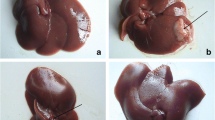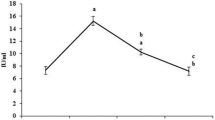Abstract
Chemopreventive effect of S-allylcysteine (constituent of garlic) on N-nitrosodiethylamine (NDEA)-induced hepatocarcinogenesis was evaluated in Wistar rats. Significantly decreased lipid peroxidation products (thiobarbituric acid reactive substances-TBARS and lipid hydroperoxides) with increased level of reduced glutathione, increased activities of glutathione S-transferase, and glutathione peroxidase were observed in liver of NDEA-treated rats when compared with control rats. The activities of superoxide dismutase and catalase were significantly decreased in tumor tissue when compared with control. Administration of S-allylcysteine (SAC) showed the inhibition of tumor incidence, modulated the lipid peroxidation, and increased the reduced glutathione, glutathione-dependent enzymes, superoxide dismutase, and catalase in NDEA-induced carcinogenesis. From our results, we speculate that S-allylcysteine mediates its chemopreventive effects by modulating lipid peroxidation, GST stimulation, and by increasing the antioxidants. Hence SAC prevents cells from loss of oxidative capacity in NDEA-induced hepatocarcinogenesis.







Similar content being viewed by others
References
Sharma RA, Farmer PB (2004) Biological relevance of adduct detection to the chemoprevention of cancer. Clin Cancer Res 10(15):4901–4912
Leykum LK, El-Serag HB, Cornell J, Papadopoulos KP (2007) Screening for hepatocellular carcinoma among veterans with hepatitis C on disease stage, treatment received, and survival. Clin Gastroenterol Hepatol 5(4):508–512
Poduri CD (2003) Hepatitis C virus (HCV) – a review; molecular biology of the virus, immunodiagnostics, genomic heterogeneity and the role of virus in hepatocellular carcinoma. Indian J Exp Biol 41(6):549–562
Hara A, Sakata K, Yamada Y, Kuno T, Kitaori N, Oyama T, Hirose Y, Murakami A, Tanaka T, Mori H (2005) Suppression of beta-catenin mutation by dietary exposure of auraptene, a citrus antioxidant, in N, N-diethylnitrosamine-induced hepatocellular carcinomas in rats. Oncol Rep 14(2):345–351
Sakata K, Hara A, Hirose Y, Yamada Y, Kuno T, Katayama M, Yoshida K, Zheng Q, Murakami A, Ohigashi H, Ikemoto K, Koshimizu K, Tanaka T, Mori H (2004) Dietary supplementation of the citrus antioxidant auraptene inhibits N, N-diethylnitrosamine-induced rat hepatocarcinogenesis. Oncology 6(3):244–252
Yadav AS, Bhatnagar D (2007) Chemo-preventive effect of Star anise in N-nitrosodiethylamine initiated and phenobarbital promoted hepato-carcinogenesis. Chem Biol Interact 169:207–214
Moreno FS, Toledo LP, de Conti A, Heidor R, Jordão A Jr, Vannucchi H, Cardozo MT, Ong TP (2007) Lutein presents suppressing but not blocking chemopreventive activity during diethylnitrosamine-induced hepatocarcinogenesis and this involves inhibition of DNA damage. Chem Biol Interact 168(3):221–228
Buchmann A, Schwarz M, Schmitt R, Wolf CR, Oesch F, Kunz W (1987) Development of cytochrome P-450-altered preneoplastic and neoplastic lesions during nitrosamine-induced hepatocarcinogenesis in the rat. Cancer Res 47(11):2911–2918
Cerutti PA (1985) Prooxidant states and tumor promotion. Science 227:375–381
Leoppky RN, Li YK (1985) Nitrosamine activation and detoxification through free radicals and their derived cations. In: Neill IKO, Chen J, Bartsch H (eds) Relevance to human cancer of nitroso compounds. Tobacco and mycotoxins. IARC Scientific Publication No. 105, Lyon, pp 375–382
Lee BH, Lee SJ (1999) Preventive effects of mixed disulphide from dithiocarbamate and N-acetylcysteine on the genotoxicity of N-nitrosodiethylamine. J Pharm Pharmacol 51:105–109
Sengupta A, Ghosh S, Das S (2004) Modulatory influence of garlic and tomato on cyclooxygenase-2 activity, cell proliferation and apoptosis during azoxymethane induced colon carcinogenesis in rat. Cancer Lett 208(2):127–136
Wen J, Zhang Y, Chen X, Shen L, Li GC, Xu M (2004) Enhancement of diallyl disulfide-induced apoptosis by inhibitors of MAPKs in human HepG2 hepatoma cells. Biochem Pharmacol 68(2):323–331
Perez-Severiano F, Salvatierra-Sanchez R, Rodriguez-Perez M, Cuevas-Martinez EY, Guevara J, Limon D, Maldonado PD, Medina-Campos ON, Pedraza-Chaverri J, Santamaria A (2004) S-Allylcysteine prevents amyloid-beta peptide-induced oxidative stress in rat hippocampus and ameliorates learning deficits. Eur J Pharmacol 489(3):197–202
Maldonado PD, Chanez-Cardenas ME, Pedraza-Chaverri J (2005) Aged garlic extract, garlic powder extract, S-allylcysteine, diallyl sulfide and diallyl disulfide do not interfere with the antibiotic activity of gentamicin. Phytother Res 19(3):252–254
Oberley LW, Buettner GR (1979) Role of SOD in cancer. A review. Cancer Res 39:1141–1149
Amagese H, Milner JA (1993) Impact of various sources of garlic and their constituents on 7, 12 dimethylanthracene binding to cell DNA. Carcinogenesis 14:1677–1681
Cohen LA, Zhao Z, Pittman B, Lubet R (1999) S-allylcysteine, a garlic constituent, fails to inhibit N-methylnitrosourea-induced rat mammary tumorigenesis. Nutr Cancer 35(1):58–63
Sundaresan S, Subramanian P (2003) S-allylcysteine inhibits circulatory lipid peroxidation and promotes antioxidants in N-nitrosodiethylamine-induced carcinogenesis. Pol J Pharmacol 55:37–42
Saydam N, Kirb A, Demir O, Hazan E, Oto O, Saydam O (1997) Determination of glutathione reductase, glutathione peroxidase and glutathione - S transferase levels in human lung cancer tissues. Cancer Lett 119:13–19
Sundaresan S, Subramanian P (2002) Evaluation of chemopreventive potential of garlic extract on N-nitrosodiethylamine-induced hepatic carcinoma in rats. Pharm Biol 40:PB067–PB072
Ohkawa H, Ohishi N, Yagi K (1979) Assay for lipid peroxides in animal tissues by thiobarbituric acid reaction. Anal Biochem 95:351–358
Jiang ZY, Hunt JV, Wolf SP (1992) Detection of lipid hydroperoxides using the FOX method. Anal Biochem 202:384
Ellman GL (1959) Tissue sulfhydryl groups. Arch Biochem Biophys 82:70–77
Rotruck JT, Pope AL, Gauther HE, Swanson AB, Hafeman DC, Hoekstra WG (1973) Selenium: biochemical roles as a component of glutathione peroxidase. Science 179:588–590
Habig WH, Pabst MJ, Jakoby WB (1974) Glutathione-S transferase, the first enzymatic step in mercapturic acid formation. J Biol Chem 249:7130–7139
Kakkar PN, Das B, Viswanathan P (1984) A modified spectrophotometric assay of Superoxide dismutase. Indian J Biochem Biophys 21:130–132
Sinha AK (1972) Colorimetric assay of catalase. Anal Biochem 47:389–394
Lowry OH, Rosebrough NJ, Farr AL, Randall RJ (1951) Protein Measurement with the folin phenol reagent. J Biol Chem 193:265–275
Balasenthil S, Rao KS, Nagini S (2002) Apoptosis induction by S-allylcysteine, a garlic constituent, during 7,12-dimethylbenz[a]anthracene-induced hamster buccal pouch carcinogenesis. Cell Biochem Funct 20(3):263–268
Lee ES, Steiner M, Lin R (1994) Thioallyl compounds potent inhibitor of cell proliferation. Biochem Biphys Acta 1221:73–77
Lu YP, Lou YR, Yen P, Newmark HL, Mirochnitchenko OC, Inouye M (1997) Enhanced skin carcinogenesis in transgenic mice with high expression of glutathione peroxidase. Cancer Res 57:1468–1474
Dianzani MU (1993) Lipid peroxidation and cancer. Crit Rev Oncol Haematol 15:125–147
Hatano S, Jimenez A, Wargovich MJ (1996) Chemopreventive effect of SAC and its relationship to the detoxification enzyme glutathione S-transferase. Carcinogenesis 17:1041–1044
Slater TF, Benedetto C, Burton GW, Cheeseman KH, Ingold KG, Nodes JT (1984) Lipid peroxidation in animal tumors. A disturbance in the control of cell division. In: Thaler-Dao H, Crarter de paulet A, Paoletti R (eds) Eicosanoids and cancer. Raven Press, New York, pp 21–29
Prestera T, Zhang Y, Spencer SR, Wilczak C, Talalay P (1993) The electrophilic counter attack responses: protection against neoplasia and toxicity. Adv Enzyme Regul 33:281–296
Church S, Grant J, Ridnour L, Oberley L, Swanson P (1993) Increased manganese superoxide dismutase expression suppresses the malignant phenotype of human melanoma cells. Proc Natl Acad Sci USA 90:3113–3117
Author information
Authors and Affiliations
Corresponding author
Rights and permissions
About this article
Cite this article
Sundaresan, S., Subramanian, P. Prevention of N-nitrosodiethylamine-induced hepatocarcinogenesis by S-allylcysteine. Mol Cell Biochem 310, 209–214 (2008). https://doi.org/10.1007/s11010-007-9682-4
Received:
Accepted:
Published:
Issue Date:
DOI: https://doi.org/10.1007/s11010-007-9682-4




